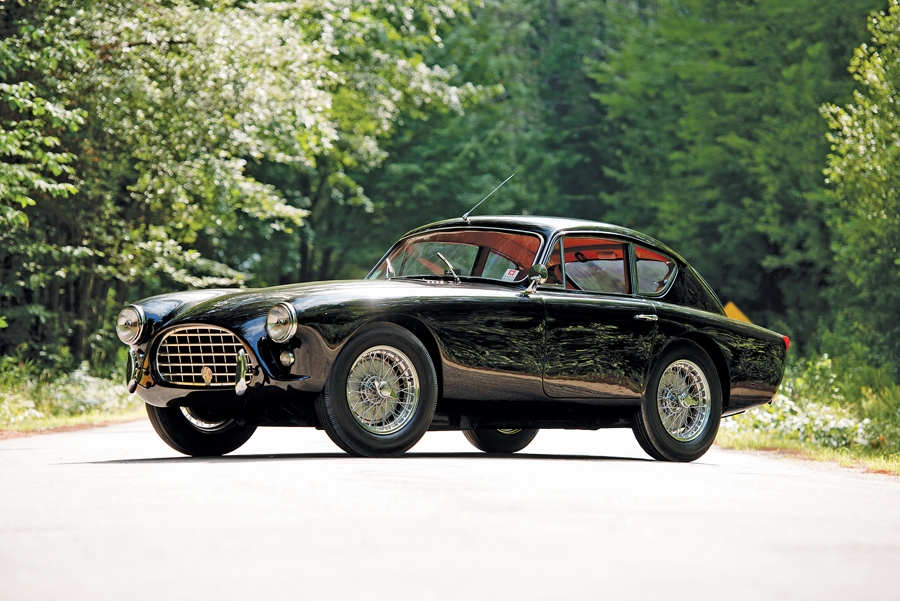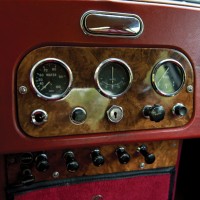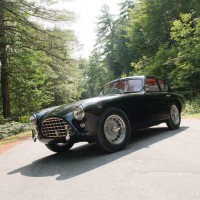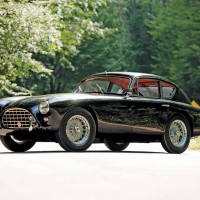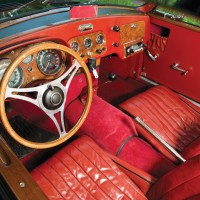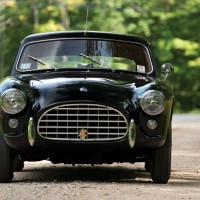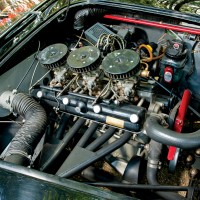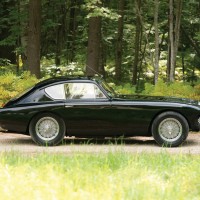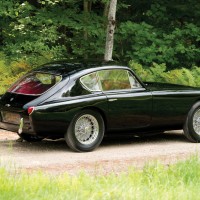1958 Aceca Bristol chassis BEX678
The Aceca Bristol offered here has its original Bristol engine, the number of which matches the car’s original firewall tag. According to the consignor, John Moir, the car’s original owner was Peter Winston, the son of renowned New York City jeweler Harry Winston.
Young Mr. Winston used the car as an everyday driver in Manhattan for some years, after which he sold it through an acquaintance to Tom Hickey, a well-known motorcycle and sports car racer from Cambridge, MA.
Mr. Hickey sent the Aceca Bristol back to AC Cars in Thames-Ditton, where it was totally refurbished to its original condition by the factory that had built it new. Upon its return stateside, the proud owner displayed the car at various New England sports car events, where it was very popular and became well known as one of the finest Aceca Bristols in the world. Only when Mr. Hickey was stricken with a tragic illness did he sell his pet to perhaps the most avid of its many admirers, John Moir. It has remained a great favorite in the Moir Collection ever since.
The past three decades have left the car with a wonderful, rich patina, a term often overused but well-applied here. The red leather interior has softened and been broken-in gently, and it is as comfortable as it appears. The dashboard instruments and interior trim are still in beautiful condition throughout, and the black finish, which has only the lightest of wear, is still in good condition; it will polish out well for local shows or continued driving. Overall, the car is best described as resembling what a well-kept, gently driven Aceca Bristol would have looked like in 1968.
1960 Aceca Bristol chassis AEX756
The example offered here was completed at Thames Ditton on January 4, 1960, and it was sold new as a left-hand-drive example to North America. While originally delivered with an AC two-liter engine, the car was fitted, under the previous owner’s tenure, with the desirable 1,971-cubic-centimeter Bristol engine and gearbox.
After being acquired by the current owner in 2010, a comprehensive restoration of this Aceca Bristol coupe was recently finished by renowned British car specialists at Kevin Kay Restorations in Redding, CA.
The aluminum body panels were taken down to bare metal prior to a show-quality repaint, and it should be noted that the body required a minimal amount of metalwork during restoration. The interior was newly trimmed in correct materials, and every component was either rebuilt or restored, as needed, including a new front windscreen.
The braking system was rebuilt, Spax shocks were fitted, and some of the new components include a stainless-steel exhaust system and all of the wiring and rubber seals. The body is finished in an original AC shade of Slate Blue, and the interior is trimmed in black leather with gray carpet, making for a very stunning appearance. This is a superb chance to slip behind the wheel of a freshly and extensively restored, dashing British sports car that exhibits the outstanding performance that took the world by storm in the mid-1950s.
1959 Aceca Bristol chassis BEX711
This Bristol-powered Aceca, with chassis number BEX711, was AC’s display vehicle at the 1959 New York International Automobile Show. At the show, it caught the eye of William Willock Jr., who purchased the car. This was one of eight examples delivered to the United States in 1959. The car was purchased for his son Norman, a recent university graduate. Norman enjoyed the car occasionally until moving to the Virgin Islands, with the Aceca placed into long-term storage at a family property in Maryland in the late 1960s. Norman returned to the United States circa 1988, and settled in Tucson. His Aceca was removed from storage and delivered to him. During the late 1990s, the car was given a sympathetic restoration, which included rebuilding of the Bristol engine, a bare-metal repaint in the original gunmetal gray, and re-trimming of the interior in red leather as original. The work was completed in 2001. In 2007, it was acquired by Norman’s son. Since new, the car has traveled fewer than 15,700 original miles. The 1,971-cc overhead valve inline 6-cylinder engine is fitted with triple Solex carburetors and offers 128 horsepower. There is a 4-speed manual gearbox with Girling disc brakes in the front and hydraulic drums in the rear.
SCM Analysis
Detailing
| Vehicle: | 1958 AC Aceca Bristol |
| Years Produced: | 1954–63 |
| Number Produced: | 328 (all engine types) |
| Original List Price: | $52,000 |
| SCM Valuation: | $115,000–$175,000 |
| Tune Up Cost: | $375 |
| Distributor Caps: | $100 |
| Chassis Number Location: | Plate on firewall; stamped on engine mountings |
| Engine Number Location: | Right side of block near starter |
| Club Info: | AC Owners Club |
| Website: | http://www.acownersclub.co.uk |
| Alternatives: | 1955–57 Aston Martin DB 2/4 Mk III, 1960–65 Lancia Flaminia GT, 1960–61 Porsche 356B coupe |
| Investment Grade: | B |
1958 AC Aceca Bristol chassis BEX678, Lot 139, sold for $214,500, including buyer’s premium, at RM Auctions’ Hershey, PA, sale on October 9, 2014.
1960 AC Aceca Bristol chassis AEX756, Lot 210, sold for $286,000, including buyer’s premium, at the RM Auctions’ Monterey, CA, sale on August 16, 2014.
1959 AC Aceca Bristol chassis BEX711, Lot 65, sold for $275,000, including buyer’s premium, at the Gooding & Co. Pebble Beach, CA, sale on August 16, 2014.
It’s always a comfort when manufacturers make it easier for us to determine how a car was originally built. Want to know if an AC was delivered with the AC inline 6-cylinder or the BMW-derived Bristol 6? Simple. If the chassis ID starts with “A,” it means “AC,” and “B” means “Bristol.” So, of course, as everyone bad-mouths the “ancient” AC unit, loves the Bristol engine and engine swaps are definitely a deal-killer, the car born with the “wrong” engine and which has the swap brought the biggest price. Clear?
Now that you’ve absorbed that, be prepared to forget other “absolute truths” your friends tell in bars, on concours fields and in the garages of other friends they don’t really like.
From roadster to coupe
Everybody knows that the AC Ace roadster was only good as a placeholder for a decade until it was rescued from obscurity to become the Shelby/AC Cobra. Or was that the case at all? I think not.
For many years, owners of AC- and Bristol-powered Aces quietly enjoyed their cars and fended off inquiries on why their “Cobras” looked and sounded so strangely anemic.
While there’s no doubt that what Shelby American brought to the table in creating the Cobra was remarkable, there’s also a good reason Carroll Shelby looked to the Ace as a source to develop.
Since every respectable sports car maker — especially one based under the less-than-balmy skies of Britain — must have a more serious closed model to sell to adventurous doctors and solicitors, the Ace quickly gained a GT stablemate, the Aceca.
Rarely has a perfect roadster shape such as the Ace spawned an equally attractive closed version. While it lacks some of the grace an Italian carrozzeria would have given it, the lines are harmonious and the cabin has useful space.
A glance back at the 2007 SCM Pocket Price Guide shows Acecas listed in a range from $40,000 to $70,000, with Ace Bristol roadsters pegged at just over twice those figures.
The brand-new 2015 SCM Pocket Price Guide lists the Aceca at $115,000 to $175,000 and the Ace Bristol roadsters at $225,000 to $335,000. Both represent an increase in prices parallel in movement. What we’ve now seen — confirmed in these three sales — may likely be a narrowing of the differential between GT and roadster similar to what we’ve seen in the Mercedes 300SL market.
Loving a metal roof
It is really a matter of personal preference. I am, as most readers of my work for decades now know, very much a tin-top guy. Give me a choice between a swoopy roadster, convertible or cabriolet, and I’m more than likely to ask if there are any coupes or sedans available. I think I was born “GT Man.” There’s nothing quite like a roof over your head and windows to roll up and down while blasting down a sinuous river road or over a winding mountain track. Besides the inherent added torsional rigidity, I like the coddled feeling you get in a GT car.
In March 2011, I drove a lovely, nicely patinated 1957 Aceca during the preview of the Gooding & Co. Amelia Island sale.
Powered by the veteran AC engine, it was a delight to drive, and unlike many other occasions on which an object of long affection disappoints at first hands-on experience, it surpassed my expectations. I later had the chance to drive a Bristol-engined version, and my devotion was assured.
The Aceca I drove in Florida sold near the low estimate at $110,000, surprising many who expected it to go for rather less, but not me. I was, however, simply disappointed that another car I loved seemed to be heading out of reach.
All three sales click
The cars we are discussing here all sold exactly where they should have relative to condition. Taking into account the dates of last restoration and specification, it all makes logical sense.
AEX756 was the freshest of the cars and presented itself extremely well in a terrific, very period color.
BEX711, an original Bristol-engined car with low mileage, sold nearly as well as AEX756 — despite having been restored nearly a decade earlier.
BEX768 had been restored at the factory but had the oldest restoration, approximately 30 years old, which now showed considerable patina. It had also been lightly used for a number of years in the collection of John Moir.
I would argue that a freshly restored, original BEX example would now handily surpass all three of these cars in price.
That AEX756 could sell as the highest of this trio despite not having been born with the Bristol engine tells you a great deal about how the Aceca has risen in the esteem of a larger audience.
In fact, the buyers of that particular car are SCMers who wrote a letter published in the January 2015 issue (“You Write, We Read,” p. 36) explaining why they “paid so much” for the car.
It came to down to what the letter writer — Michelle Rand — illustrated: “We LOVE this car…” At the end of the day, it’s passion that rules this world. The cars that inspire that passion are most often the ones that perform best in the market, especially when more people become more sensitive and aware of their particular charms. And the Aceca is a very charming 1950s GT indeed. ♦
(Introductory descriptions courtesy of RM Auctions and Gooding & Company.)
